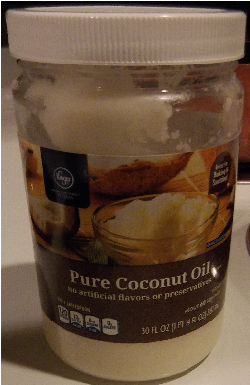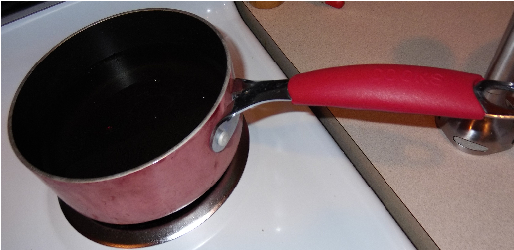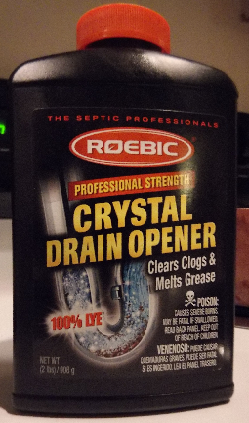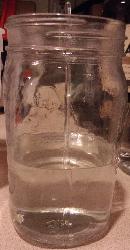Bar Soap
There are many kinds of oils. Avocado. Olive. Peanut. Coconut. Pork lard. Each of them has a different combination of fatty acids that changes the recipe slightly. The recipe below details how to make a very specific coconut and sunflower oil soap scented with peppermint and eucalyptus, however, the button on the upper right labelled "Print Recipe" has not only a condensed step-by-step recipe for bar soap, but also a table on how to tweak the recipe for each type of oil. Remember, when using different kinds of oils that saturated fats like Coconut Oil, Lards, Illipe, and Palm Kernel Oil create harder soaps that suds up, whereas unsaturated fats like Corn Oil, Olive Oil, Sunflower Oil, and Walnut Oil create creamy and soft soaps.
To make soap, you'll need proper hardware, software, and safety equipment.
| Coconut-Sunflower Peppermint-Eucalyptus Soap Bars | ||
| Hardware | Software | Safety Equipment |
|
|
|
† NaOH will produce noxious fumes when it is initially added to water. A respirator is not required if you can safely vent the fumes with an overhead stovetop vent or a boxfan in a window.
| Instructions | |
| 1. | Measure out the 10.73 oz. of Coconut Oil and 21.91 oz. of Sunflower Oil directly into the teflon pot on the scale. Remember to zero-out the scale before adding any oil to the pot. It's important to add the oil directly to the pot because oils stick to the sides of containers and you can never get all of it out of an intermediate container. By reducing the number of containers between weighing out the oil and adding in the NaOH, it reduced the chances that you have too much lye in your soap. That would burn your skin. That would be bad. |
 |
|
| 2. | Heat the pot on the stove on medium-low heat. Coconut oil is a solid at room temperature. In order to get the NaOH to react with the oils, it needs to be a liquid. |
 |
|
| 3. | While the oils are melting, in the glass jar, weigh out the 12.5 oz. water on the scale. You don't need to worry about rounding error with the water nearly as much as with the oil or the NaOH. The purpose of the water is to dissolve the NaOH so that it can ionize both the OH- and Na+ so that it can react with the oils. The water also makes the final soap soft to the touch, rather than hard and abrasive. |
| 4. | Add the 5 oz. of NaOH to the jar. Be very careful not to add too much lye. If you are concerned about adding too much or the accuracy of your scale, reduce the amount of lye by approximately 0.1 oz. or, if your scale is like mine, reduce by 1/8 oz. The process of dissolving lye in water not only produces noxious fumes, but it also is highly exothermic, which means that it produces a lot of heat. By the end of the dissolution of the NaOH, the temperature of the solution will be around 200°F. |
 |
|
| 5. | Using the glass stirring rod, stir the NaOH until it dissolves. NaOH is hygroscopic meaning that it absorbs water out of the atmoshere. It also means that when added to water, it will clump up and make it difficult to stir. Not if, but when that happens, don't force it. You'll break the stirring rod. Instead, let it sit for a minute. It'll dissolve a litle more and the clumps will break up. |
 |
|
| 6. | After the oil has melted, pour it into the plastic bucket. Use the spatula to scrape down the interior as much as possible to get as much of the oil into the bucket as possible. Then, use the candy thermometer to monitor the temperature of the oil. It needs to be between 100°F and 120°F before adding the NaOH solution. Using the same thermometer (wiping it off with the paper towel while switching liquids), monitor the temperature of the NaOH solution. It also needs to be between 100°F and 120°F. |
 |
|
| 7. | Once the temperature of both liquids are in the zone, carefully pour the NaOH solution into the oil in the bucket. |
Whenever working with dangerous chemicals, especially corrosive chemicals like strong acids, or, like this NaOH solution, caustic chemicals like strong bases, always pour the dangerous chemical INTO the non-dangerous chemical. In the event of splashing, the liquid that splashes is the liquid that was in the container first. 120°F oil might be a little hot, but the NaOH solution will chemically burn your skin. That is much worse. Remember that it should be alphabetical. Acid Into Water. Even if it's a base being added to acetone, the point is the dangerous chemical being added into the non-(less)-dangerous chemical. Acid Into Water. If you splash any NaOH onto your skin or on any surface, use the vinegar spray to neutralize the NaOH. |
|
| 8. | Use the immersion blender and blend the mixture thoroughly. This will take a while (3-5 minutes). The mixture will begin to become thick like a pudding (called trace). Once it becomes thick enough that it will hold it's own peaks (it will look like Vanilla pudding), add the Vitamin E Acetate, Peppermint Oil, and Eucalyptus Oil. Then continue to blend the mixture making sure that the Peppermint, Eucalyptus, and Vitamin E Acetate are fully immersed. |
 |
|
| 9. | Pour/scoop the soap into the molds. Make sure that you use the spatula to work out any air pockets. |
| 10. | Cover the molds with a sheet of wax paper and then on top of that with the tea towel. Set the mold aside, covered, and let it sit for 24 hours. |
| 11. | Uncover the molds, saving the wax paper, and pop the soap bars out. Then, set the soap bars on the wax paper and let them air out, rotating the bars once after day three. This step is important because not all the NaOH and oil will react when blending it in the bucket. You need about a week to let it cure and finish the reaction. | 12. | When not using these bars, store them in an airtight container with a wadded up paper towel inside (to suck up extra moisture) in the back of a dark cabinet. |